Permeability and Disintegration Characteristics of Loess Solidified by Guar Gum and Basalt Fiber
Abstract
:1. Introduction
2. Materials and Methods
2.1. Test Materials
2.2. Sample Preparation
2.3. Test Method
3. Results and Analysis
3.1. Analysis of Permeability and Disintegration Characteristics of the Loess Solidified by Guar Gum
3.2. Analysis of Permeability and Disintegration Characteristics of the Loess Reinforced by Basalt Fiber
3.3. Analysis of Permeability and Disintegration Characteristics of the Loess Solidified by Guar Gum and Basalt Fiber
3.4. Analysis of the Mechanism of Action for the Loess Solidified by Guar Gum and Basalt Fiber
3.5. XDR Diffraction Analysis Test for the Loess Solidified by Guar Gum and Basalt Fiber
4. Modeling of Permeability of Loess Jointly Solidified by Guar Gum and Basalt Fiber
4.1. Model Building
4.2. Model Parameter Fitting
4.3. Model Verification
5. Conclusions
- (1)
- The permeability of the loess strengthened through guar gum decreases as the confinement pressure increases. Under the same confining pressure, the permeability of solidified loess gradually decreases with increasing guar gum content. Compared with untreated soil, the permeability coefficient of guar gum-solidified soil was reduced by 50.50% under a confining pressure of 25 kPa. The disintegration rate of guar gum-solidified loess decreased significantly with the increase in guar gum content. When the guar gum content is 1.00%, the disintegration rate of solidified soil is reduced by 94.1%. After a specific period, the sample disintegration rate steadily tends to be stable. By combining the permeability characteristics with the disintegration characteristics of solidified loess, we can learn that the optimal guar gum content is 1.00%.
- (2)
- If the fiber content is constant, the permeability of the basalt fiber-fortified loess increases first, followed by a decreasing trend as the fiber length increases. Compared with untreated soil, when the fiber length is 8 mm, the permeability coefficient of solidified loess is increased by 12.70%. With the increase in fiber content, the permeability of fiber-reinforced soil increased gradually. The final disintegration time of fiber-fortified soil shows a little-by-little increase with the increase in fiber content and fiber length. For constant fiber content and length, the permeability and disintegration of the loess jointly solidified by guar gum and basalt fiber show a gradually decreasing trend with the increase in guar gum content. The results showed that the optimal solidification conditions were as follows: guar gum 1.00%, basalt fiber length 12 mm, and content 1.00%. At this time, the permeability coefficient and disintegration rate of solidified soil were reduced by 31.90% and 95.2%, respectively.
- (3)
- Guar gum reacts with water to generate hydrogel, which has strong fluidity and can effectively fill pores. However, overdosing on guar gum will lead to a significant decrease in soil permeability, which is not conducive to vegetation growth. Basalt fibers are distributed evenly in the soil mass, and mesh support can be formed by multiple fibers to restrict the deformation and displacement of soil particles. However, an excess of fibers will lead to the separation of soil particles, which will destroy the soil structure. The fiber in the loess, jointly solidified by guar gum and basalt fiber, can increase the adhesion area of the cementing agent and better promote the cementing effect. Compared with the composite of cement and fiber-reinforced loess, the combination of guar gum and basalt fiber-reinforced loess has better water stability.
- (4)
- The experimental results are in good agreement with the predicted experimental results, indicating that the established model and parameter estimation method are suitable for predicting the permeability coefficient of guar gum basalt fiber combined with reinforcement of loess.
- (5)
- The use of guar gum combined with basalt fiber to strengthen loess can improve the stability of the slope and strengthen the roadbed. The research results of this paper can provide a reference for soil solidification engineering.
- (6)
- In practical engineering, the addition of basalt fiber and guar gum content should consider construction conditions and costs. In the future study, dry–wet cycle tests and freeze–thaw cycle tests will be conducted to study the durability of solidified soil under different environments.
Author Contributions
Funding
Institutional Review Board Statement
Informed Consent Statement
Data Availability Statement
Conflicts of Interest
References
- Luo, L.; Wang, X.; Xue, C.; Wang, D.; Lian, B. Laboratory experiments and numerical simulation study of composite-material-modified loess improving high-speed railway subgrade. Polymers 2022, 14, 3215. [Google Scholar] [CrossRef] [PubMed]
- Zhao, M.; Guo, W.; Chen, L.; Wang, S. Experiment on the frost resistance of. Modified Phospho Gypsum: A case used to Improve Baozhong Railway Subgrade loess. J. Mt. Sci. 2019, 16, 2920–2930. [Google Scholar] [CrossRef]
- Tabarsa, A.; Latifi, N.; Meehan, C.L.; Manahiloh, K.N. Laboratory investigation and field evaluation of loess improvement using nanoclay—A sustainable material for construction. Constr. Build. Mater. 2018, 158, 454–463. [Google Scholar] [CrossRef]
- Chen, G.; Zhang, Y.; Zeng, R.; Yang, Z.; Chen, X.; Zhao, F.; Meng, X. Detection of land subsidence associated with land creation and rapid urbanization in the Chinese loess plateau using time series insar: A case study of Lanzhou new district. Remote Sens. 2018, 10, 270. [Google Scholar] [CrossRef]
- Lv, Y.; Deng, L.; Fan, W. Loess collapsibility characteristics of railway engineering sites using large-scale trial immersion pit experiments. Bull. Eng. Geol. Environ. 2021, 80, 3271–3291. [Google Scholar] [CrossRef]
- Smalley, I.J.; Jefferson, I.F.; Dijkstra, T.A.; Derbyshire, E. Some major events in the development of the scientific study of loess. Earth Sci. Rev. 2001, 54, 5–18. [Google Scholar] [CrossRef]
- Guo, W.; Wang, W.; Xu, Q.; Hu, J.; Zhu, L. Distribution, failure risk and reinforcement necessity of check-dams on the Loess Plateau: A review. J. Mt. Sci. 2021, 18, 499–509. [Google Scholar] [CrossRef]
- Zhang, Y.; Yao, Y.; Du, W.; Zhou, H. Experimental study on improvement design of loess curing in engineering environment. Bull. Eng. Geol. Environ. 2021, 80, 3151–3162. [Google Scholar] [CrossRef]
- Bagheri, P.; Gratchev, I.; Rybachuk, M. Effects of xanthan gum biopolymer on soil mechanical properties. Appl. Sci. 2023, 13, 887. [Google Scholar] [CrossRef]
- Hamza, M.; Nie, Z.; Aziz, M.; Ijaz, N.; Fang, C.; Ghani, M.U.; Salman, M. Geotechnical properties of problematic expansive subgrade stabilized with guar gum biopolymer. Clean Technol. Environ. Policy 2023, 25, 1699–1719. [Google Scholar] [CrossRef]
- Jia, Z.; Yan, C.; Li, B.; Han, B.; Lan, H.; Liang, Z.; Ren, J. Performance test and effect evaluation of guar gum-stabilized loess as a sustainable slope protection material. J. Clean. Prod. 2023, 408, 137085. [Google Scholar] [CrossRef]
- Han, B.; Liu, C.; Lan, H.; Yan, C.; Li, L.; Han, Z.; Dong, Z. Time-dependency deterioration of polypropylene fiber reinforced soil and guar gum mixed soil in loess cut-slope protecting. Eng. Geol. 2022, 311, 106895. [Google Scholar]
- Vedernikov, A.; Tucci, F.; Carlone, P.; Gusev, S.; Konev, S.; Firsov, D.; Akhatov, I.; Safonov, A. Effects of pulling speed on structural performance of L-shaped pultruded profiles. Compos. Struct. 2021, 255, 112967. [Google Scholar] [CrossRef]
- Zhang, J.; Weng, X.; Liu, J. Strength and water stability of a fiber-reinforced cemented loess. J. Eng. Fiber Fabr. 2018, 13, 72–83. [Google Scholar] [CrossRef]
- Yuan, K.; Ni, W.; Lü, X.; Zhu, M. Experimental study on the performance of the modified loess by polypropylene fiber mixed with bentonite and cement. Bull. Eng. Geol. Environ. 2022, 81, 302. [Google Scholar] [CrossRef]
- Kannan, G.; Sujatha, E.R. Effect of nano additive on mechanical properties of natural fiber reinforced soil. J. Nat. Fibers 2023, 20, 2143980. [Google Scholar] [CrossRef]
- Bai, Z.; Li, D.; Zhao, D.; Lu, W.; Liu, J.P. Experimental research on collapsibility of Xi’an loess improved by calcium lignosulfonate. Coatings 2023, 13, 157. [Google Scholar] [CrossRef]
- Hou, Y.; Li, P.; Wang, J. Review of chemical stabilizing agents for improving the physical and mechanical properties of loess. Bull. Eng. Geol. Environ. 2021, 80, 9201–9215. [Google Scholar] [CrossRef]
- Li, G.; Hou, X.; Mu, Y.; Ma, W.; Wang, F.; Zhou, Y.; Mao, Y. Engineering properties of loess stabilized by a type of eco-material, calcium lignosulfonate. Arab. J. Geosci. 2019, 12, 700. [Google Scholar] [CrossRef]
- Cui, S.; Li, P.; Ji, L.; Wang, T.; Liu, Y.; Lan, Y.; Jiang, J. Superabsorbent quaternary ammonium guar gum hydrogel with controlled release of humic acid for soil improvement and plant growth. Carbohydr. Polym. 2024, 337, 122188. [Google Scholar] [CrossRef]
- Fortuna, B.; Logar, J.; Sorze, A.; Valentini, F.; Smolar, J. Influence of Xanthan Gum-Based Soil Conditioners on the Geotechnical Properties of Soils. Appl. Sci. 2024, 14, 4044. [Google Scholar] [CrossRef]
- Ma, Q.; Wu, J.; Bai, Y.; Xiao, H. Effect of Xanthan Gum on the mechanical properties of fiber-reinforced sandy soil. Bull. Eng. Geol. Environ. 2024, 83, 177. [Google Scholar] [CrossRef]
- Chen, Z.; Liu, J.; Wang, Y.; Qi, C.; Ma, X.; Che, W.; Ma, K. Wetting–drying effects on the mechanical performance of xanthan gum biopolymer-stabilized soil. Environ. Earth Sci. 2024, 83, 197. [Google Scholar] [CrossRef]
- Xue, Z.; Cheng, W.; Wang, L.; Song, G. Improvement of the shearing behaviour of loess using recycled straw fiber reinforcement. KSCE J. Civ. Eng. 2021, 25, 3319–3335. [Google Scholar] [CrossRef]
- Wang, H.; Ni, W.; Yuan, K. Mechanical properties, microstructural evolution, and environmental impacts of recycled polypropylene fiber stabilized loess. Constr. Build. Mater. 2023, 400, 132850. [Google Scholar] [CrossRef]
- Shen, Y.; Yan, H.; Wang, R.; Song, P.; He, Y. Progress with functional materials based on loess particles. Clays Clay Miner. 2021, 69, 301–314. [Google Scholar] [CrossRef]
- Xu, J.; Wu, Z.; Chen, H.; Shao, L.; Zhou, X.; Wang, S. Triaxial shear behavior of basalt fiber-reinforced loess based on digital image technology. KSCE J. Civ. Eng. 2021, 25, 3714–3726. [Google Scholar] [CrossRef]
- Chen, C.; Li, G.; Liu, J.; Xi, Y.; Nan, J. Shear strength characteristics of basalt fiber-reinforced loess. Sci. Rep. 2023, 13, 15923. [Google Scholar] [CrossRef] [PubMed]
- G/BT 50123-2019; Standard for Geotechnical Testing Method. Construction Ministry of PRC: Beijing, China, 2019.
- Jia, Z.; Yan, C.; Li, B.; Shi, Y.; Lan, H.X.; Xu, J.B.; Bao, H. Experimental study on erosion resistance and ecological slope protection of guar gum-treated fiber-reinforcement loess. Chin. J. Geotech. Eng. 2022, 44, 1881–1889. [Google Scholar]
- Xu, J.; Wu, Z.; Chen, H.; Shao, L.; Zhou, X.; Wang, S. Study on strength behavior of basalt fiber-reinforced loess by digital image technology (DIT) and scanning electron microscope (SEM). Arab. J. Sci. Eng. 2021, 46, 11319–11338. [Google Scholar] [CrossRef]
- Wang, H.; Ni, W.; Yuan, K. Improvement of strength and impermeability of fiber-reinforced loess by bentonite and polypropylene fibers: A response surface analysis. Environ. Earth. Sci. 2023, 82, 252. [Google Scholar] [CrossRef]
- Ma, Y.; Bao, H.; Yan, C.; Lan, H.; Pen, J.; Zheng, H.; Song, Z.; Liu, C. Mechanical properties and microstructure evolution of two ecological slope-protection materials under dry-wet cycles. J. Clean. Prod. 2023, 416, 137833. [Google Scholar] [CrossRef]
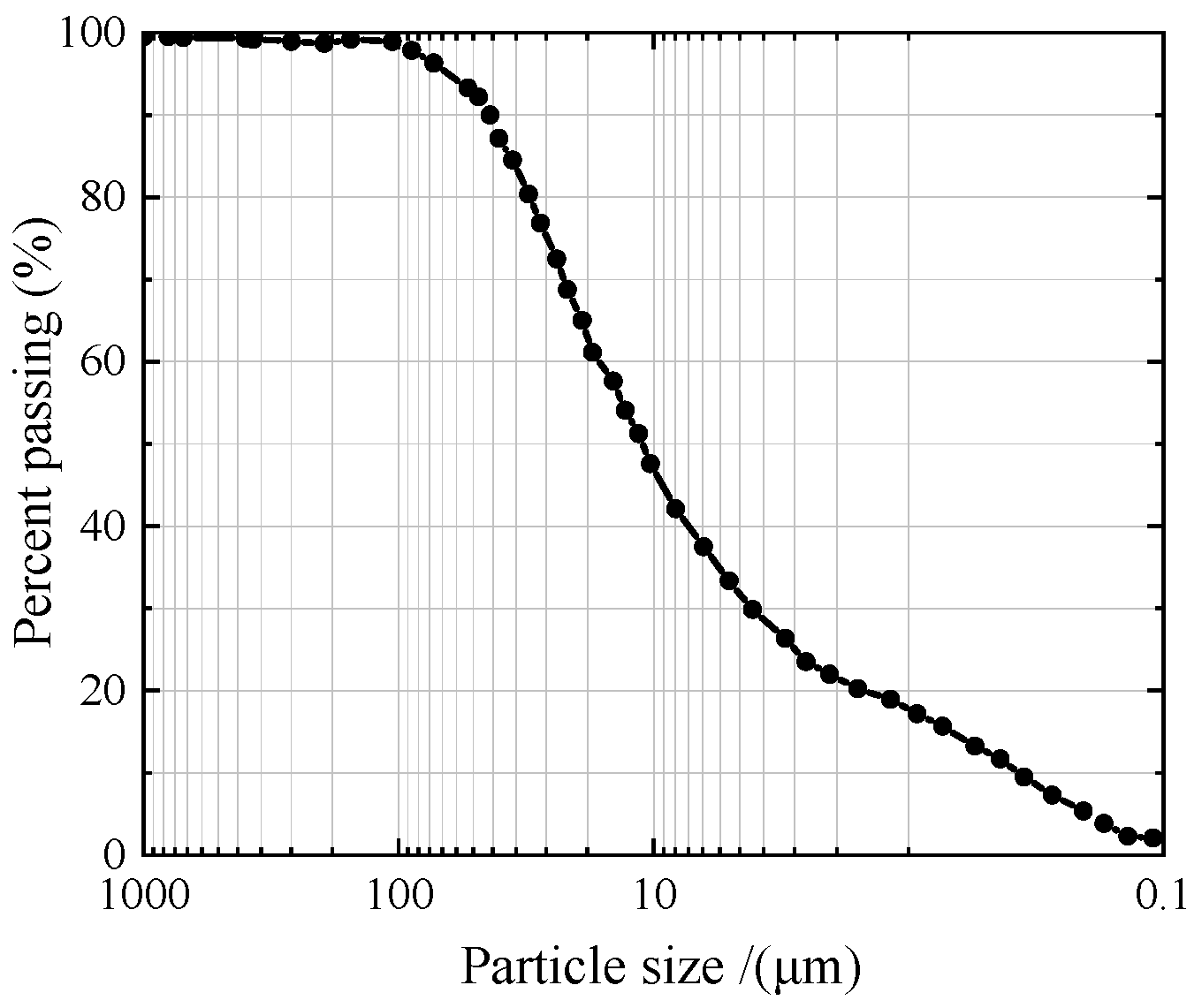
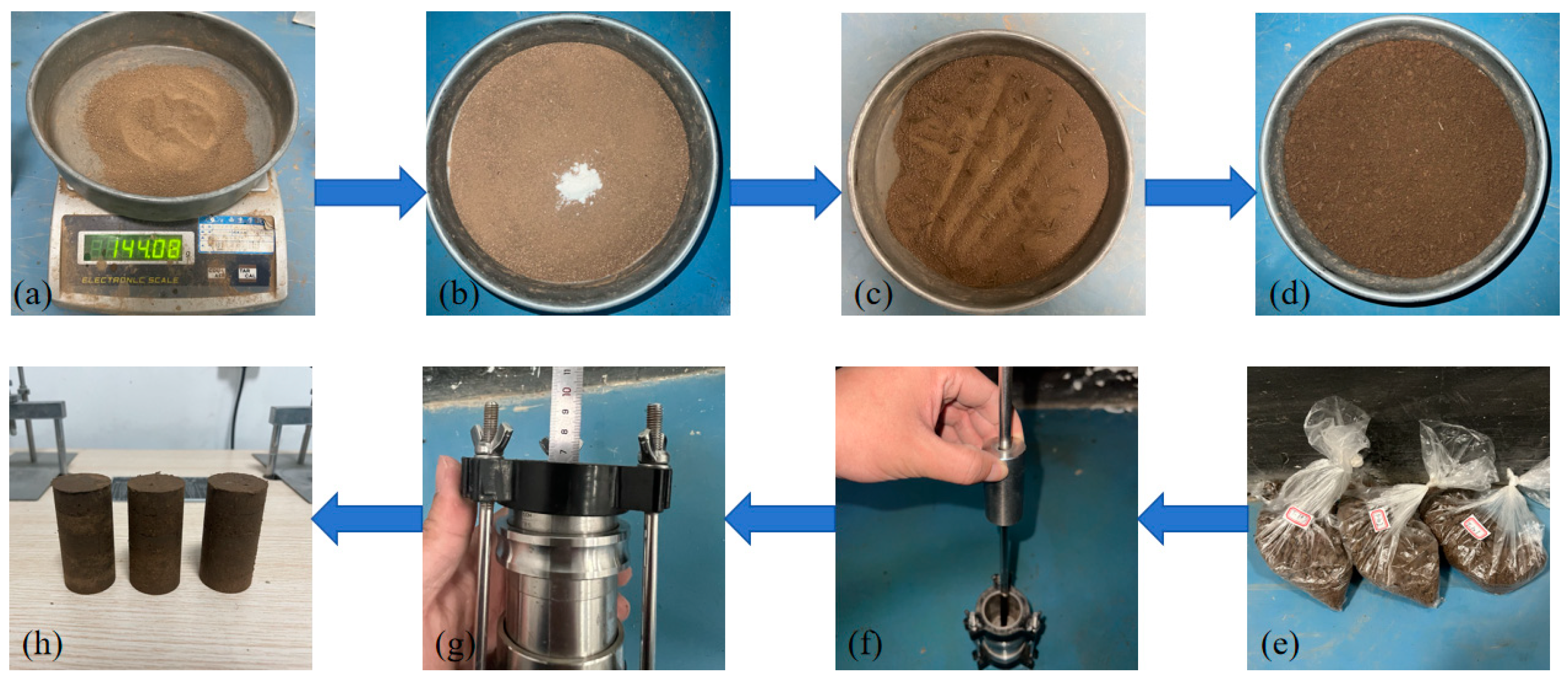
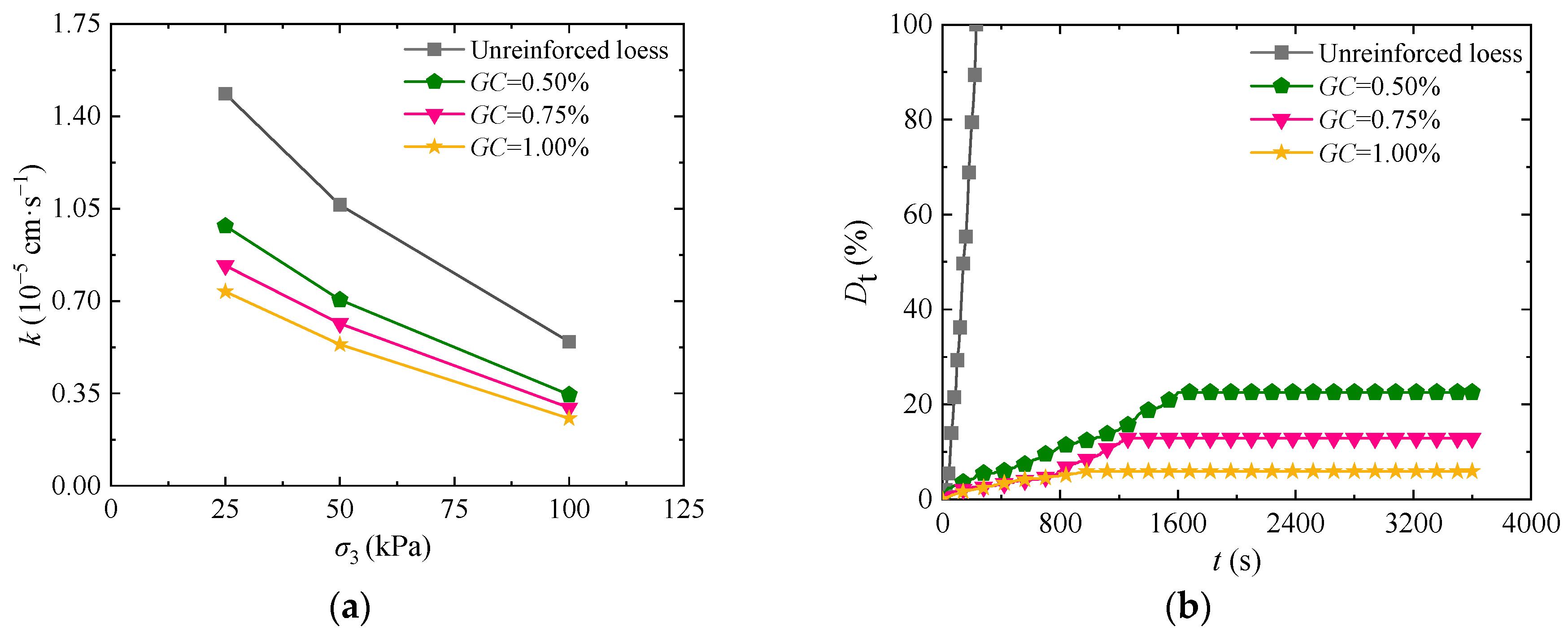


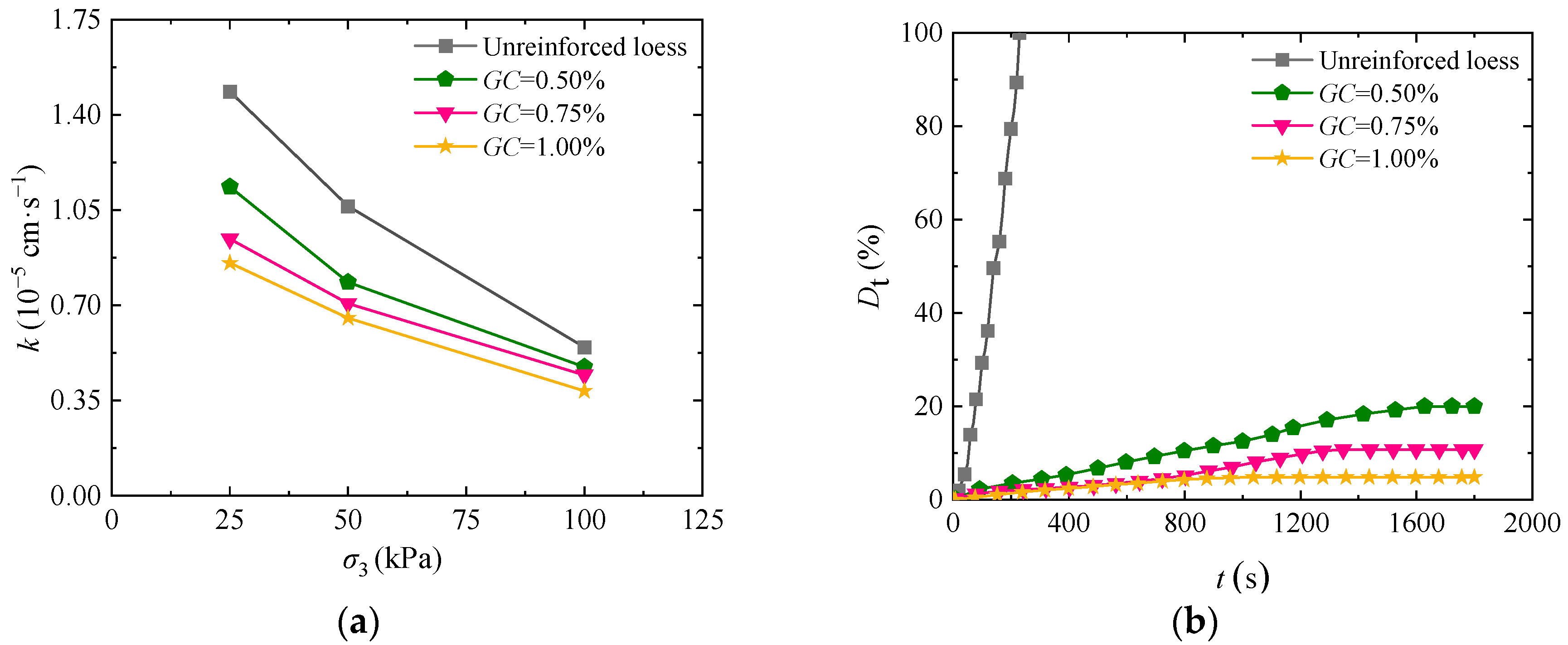
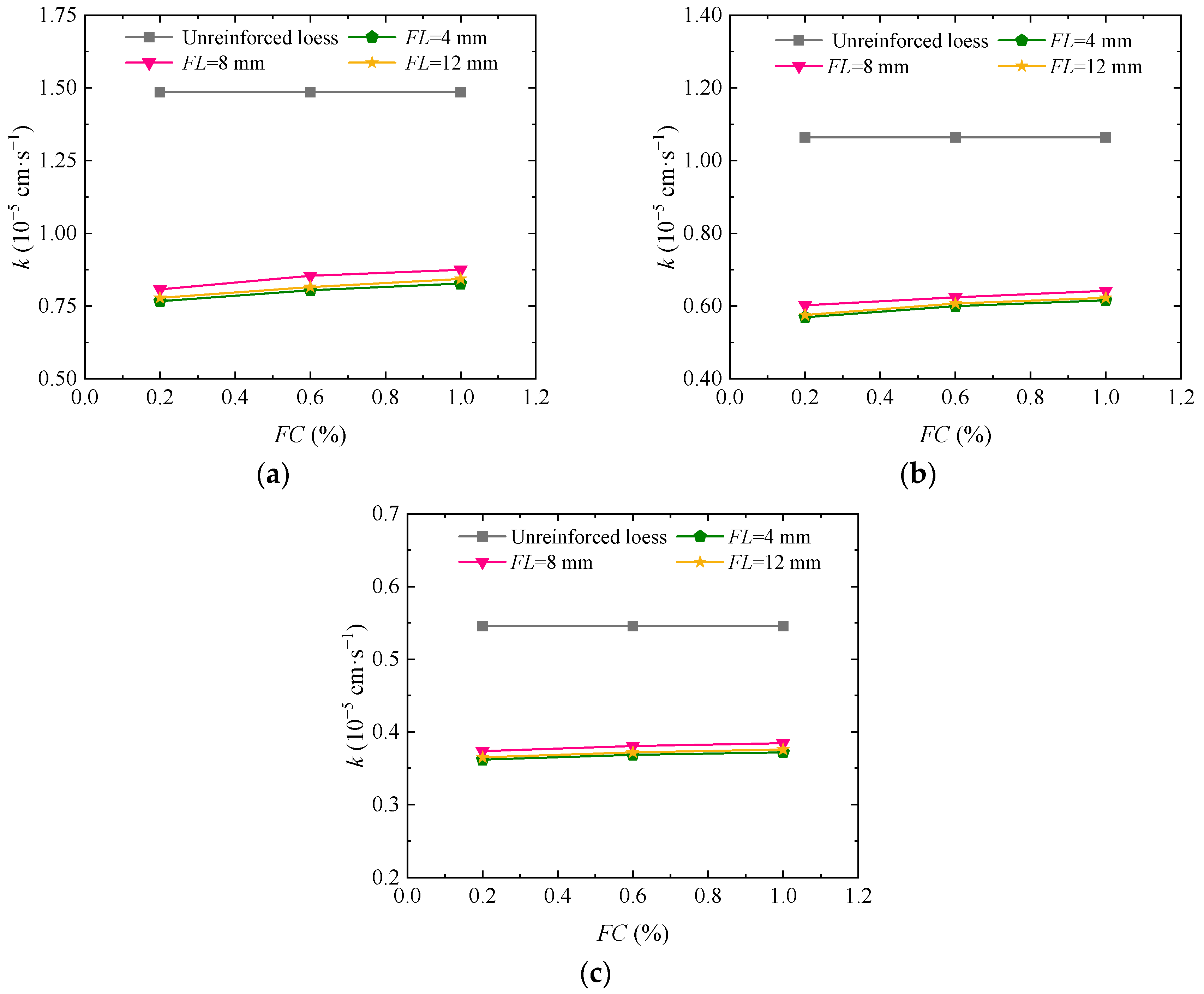
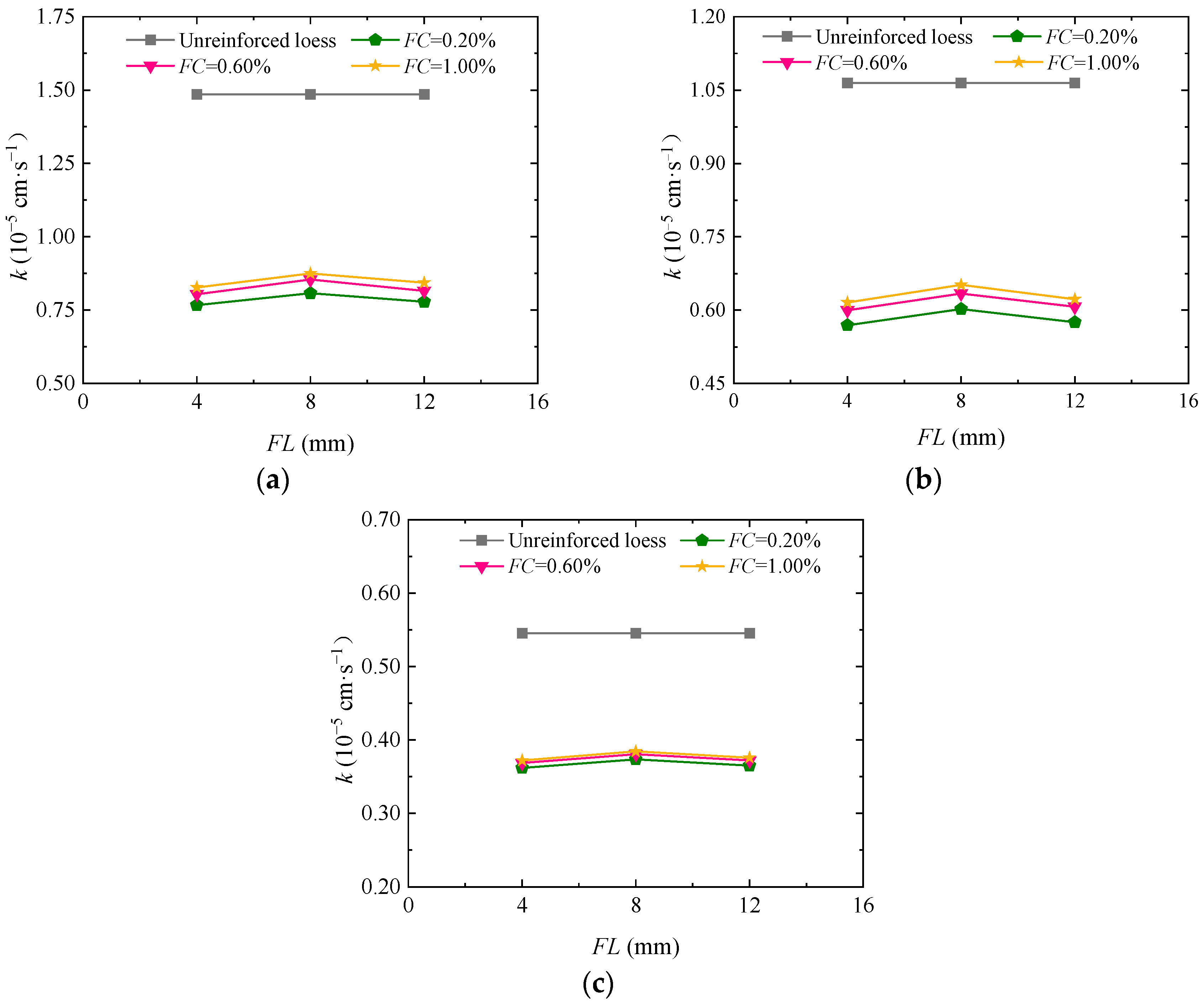
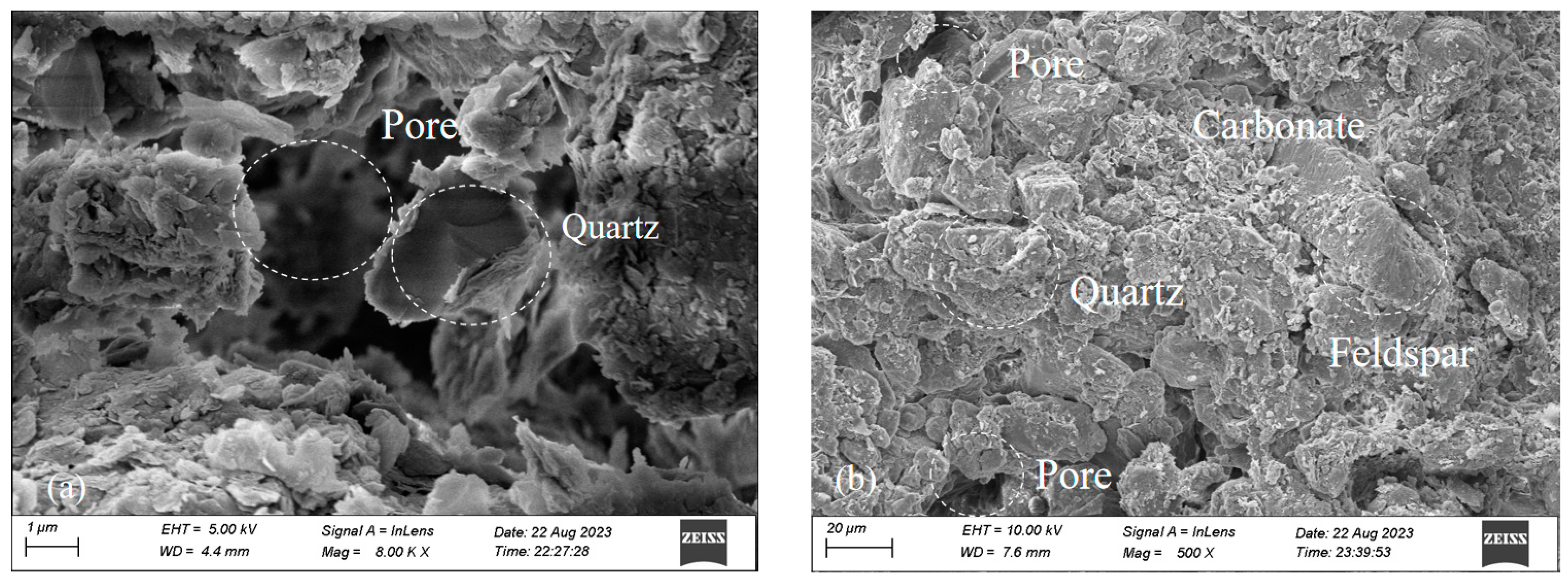

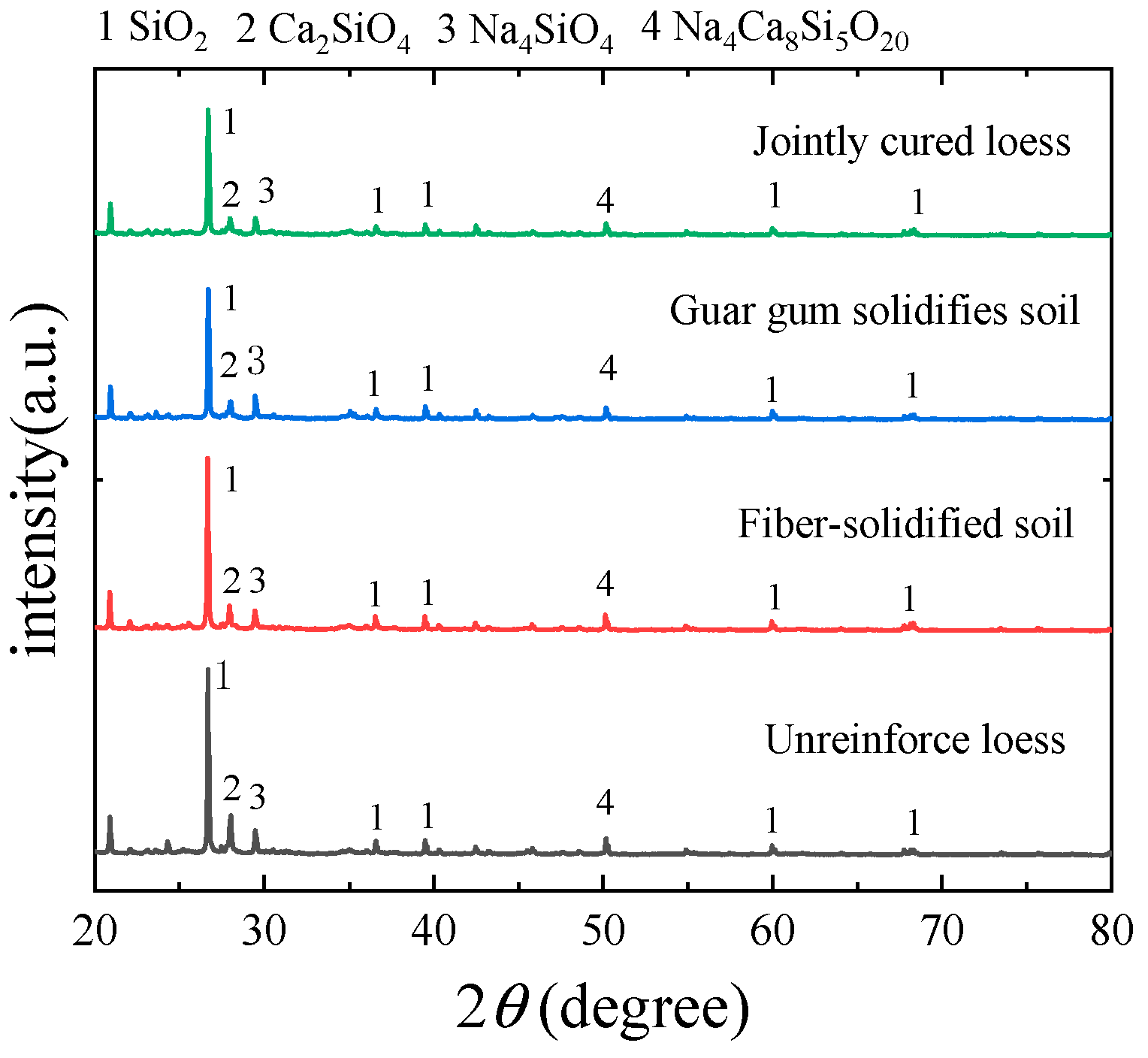


| Water Content (%) | Dry Density (g·cm−3) | Specific Gravity Gs | Initial Porosity Ratio | Plasticity Limit (%) | Liquid Limit (%) | Plasticity Index |
|---|---|---|---|---|---|---|
| 14.50 | 1.24 | 2.67 | 0.73 | 18.60 | 33.80 | 15.20 |
| Density (g·cm−3) | Diameter (μm) | Tensile Strength (MPa) | Elastic Modulus (GPa) | Elongation at Break (%) | Acid and Alkali Resistance |
|---|---|---|---|---|---|
| 2.65 | 10 | 3500~4500 | 100 | 2.20 | Strong |
| Confining Pressure σ3 (kPa) | Fiber Length FL (mm) | Fiber Content FC (%) | Guar Gum Dosage GC (%) |
|---|---|---|---|
| 25 | 0 | 0 | 0, 0.50, 0.75, 1.00 |
| 4 | 0.20, 0.60, 1.00 | 0, 0.50, 0.75, 1.00 | |
| 8 | 0.20, 0.60, 1.00 | 0, 0.50, 0.75, 1.00 | |
| 12 | 0.20, 0.60, 1.00 | 0, 0.50, 0.75, 1.00 | |
| 50 | 0 | 0 | 0, 0.50, 0.75, 1.00 |
| 4 | 0.20, 0.60, 1.00 | 0, 0.50, 0.75, 1.00 | |
| 8 | 0.20, 0.60, 1.00 | 0, 0.50, 0.75, 1.00 | |
| 12 | 0.20, 0.60, 1.00 | 0, 0.50, 0.75, 1.00 | |
| 100 | 0 | 0 | 0, 0.50, 0.75, 1.00 |
| 4 | 0.20, 0.60, 1.00 | 0, 0.50, 0.75, 1.00 | |
| 8 | 0.20, 0.60, 1.00 | 0, 0.50, 0.75, 1.00 | |
| 12 | 0.20, 0.60, 1.00 | 0, 0.50, 0.75, 1.00 |
| Fiber Length FL (%) | Fiber Content FC (%) | Guar Gum Dosage GC (%) |
|---|---|---|
| 0 | 0 | 0, 0.50, 0.75, 1.00 |
| 4 | 0.20, 0.60, 1.00 | 0, 0.50, 0.75, 1.00 |
| 8 | 0.20, 0.60, 1.00 | 0, 0.50, 0.75, 1.00 |
| 12 | 0.20, 0.60, 1.00 | 0, 0.50, 0.75, 1.00 |
| 0 | 0 | 0, 0.50, 0.75, 1.00 |
| 4 | 0.20, 0.60, 1.00 | 0, 0.50, 0.75, 1.00 |
| 8 | 0.20, 0.60, 1.00 | 0, 0.50, 0.75, 1.00 |
| 12 | 0.20, 0.60, 1.00 | 0, 0.50, 0.75, 1.00 |
| 0 | 0 | 0, 0.50, 0.75, 1.00 |
| 4 | 0.20, 0.60, 1.00 | 0, 0.50, 0.75, 1.00 |
| 8 | 0.20, 0.60, 1.00 | 0, 0.50, 0.75, 1.00 |
| 12 | 0.20, 0.60, 1.00 | 0, 0.50, 0.75, 1.00 |
Disclaimer/Publisher’s Note: The statements, opinions and data contained in all publications are solely those of the individual author(s) and contributor(s) and not of MDPI and/or the editor(s). MDPI and/or the editor(s) disclaim responsibility for any injury to people or property resulting from any ideas, methods, instructions or products referred to in the content. |
© 2024 by the authors. Licensee MDPI, Basel, Switzerland. This article is an open access article distributed under the terms and conditions of the Creative Commons Attribution (CC BY) license (https://creativecommons.org/licenses/by/4.0/).
Share and Cite
Xi, Y.; Sun, M.; Li, H.; Li, G.; Wang, P.; Li, L. Permeability and Disintegration Characteristics of Loess Solidified by Guar Gum and Basalt Fiber. Materials 2024, 17, 3150. https://doi.org/10.3390/ma17133150
Xi Y, Sun M, Li H, Li G, Wang P, Li L. Permeability and Disintegration Characteristics of Loess Solidified by Guar Gum and Basalt Fiber. Materials. 2024; 17(13):3150. https://doi.org/10.3390/ma17133150
Chicago/Turabian StyleXi, Yu, Mingming Sun, Huanhuan Li, Gang Li, Pengzhou Wang, and Li Li. 2024. "Permeability and Disintegration Characteristics of Loess Solidified by Guar Gum and Basalt Fiber" Materials 17, no. 13: 3150. https://doi.org/10.3390/ma17133150





